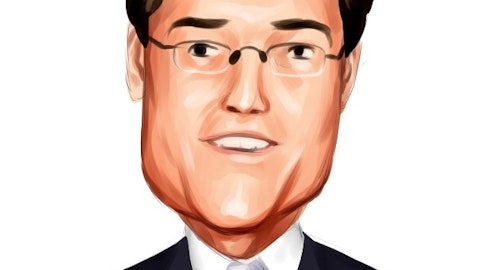So I think that as we see NAND growing — recovering and growing at a certain percentage rate, Lam will actually significantly outperform that rate because of the fact that most of that is coming from upgrades. Now longer term, I think we have turned to our attention and strategically, we’ve said we want to build resilience into our business by really capturing a lot of the opportunities that exist. Of course in NAND where we’re very strong, but really outside of NAND and some of these other markets that are becoming more etch and dep intensive. And we’ve talked about those, whether it’s gate-all-around or backside power or advanced packaging, dry EUV patterning. And each of those, we’ve characterized as a $1 billion-plus opportunity when fully scaled for Lam.
So — and those are SAM expansion meaning that they are incremental to where Lam has been before. So I think when you play those out and obviously, we have to be successful in execution. That’s why we keep talking about we’re gaining traction, but there’s still a ways to go before these inflections and all decisions are made. But we think those can certainly drive Lam to new highs in terms of revenue and obviously profitability as well.
Christopher Muse: Very helpful, Tim. I guess a quick follow-up, Doug. I know you’re hesitant to guide OpEx for the full year, but perhaps you could help us understand maybe the impact of the extra week on the March quarter? And how you’re thinking about driving that R&D growth through the calendar year?
Douglas Bettinger: Yes, C.J. I mean, it’s 14 weeks versus 13. That’s the right way to kind of think about it. You can just ratio it to understand kind of it’s a longer quarter. So that’s the piece from that. And then any delta to get to the 29.5% op margin is part of that beginning to step up R&D. As we go through the year, though, we will purposely be growing the investment in R&D so that you might not see the historic leverage that we’ve delivered is what I described a quarter ago, and that’s still very much how you should be thinking about it.
Operator: The next question is from Srinivas Pajjuri with Raymond James.
Srinivas Pajjuri: Tim, you talked about your trough EPS doubling essentially, which is a tremendous achievement and execution. I think part of the reason was your services business did increase as a percent of the mix. I think that helped for sure stabilizing the cyclicality a bit. So as we go through the next, I guess, as we kind of look out to the next couple of years as business recovers, just curious as to how you think about the mix shaking out between systems and services? And how — what sort of implications that might have for your top line and also your margin profile? And I guess, on the next peak EPS, if you want to talk about?
Timothy Archer: Well, here’s why it’s always a little difficult to answer this question is because we’re certainly investing to grow our systems business tremendously as well. And so we don’t look at it as one trading off versus the other. And so in fact, one kind of begets the other. The better our systems business does the faster our installed base grows, and that’s really the story from 2019 in that — until now, when we talk about how much the installed base has grown. We shipped a lot of new systems that grew that installed base by nearly 50%. So going forward, I think that we anticipate the ratio of CSBG revenue to overall revenue staying kind of in the historical range that it’s been. And that’s just going to be driven by kind of equivalent on success in both parts.
But the CSBG revenue, the installed base business, not only gives us stability, but it also opens new channels for growth for the company. And I’ve talked about this on previous calls, which is we — I think that when we think about how Lam leverages, things like artificial intelligence and data. It’s in the installed base services business. On the last call, I talked about even cobots, the use of collaborative robots to start to do some of the service that today is done by skilled engineers. Our customers in this industry have to find ways to be able to innovate faster and also provide manufacturing services at a lower cost. And I think that — we can do that by innovating around the installed base and create new products and service offerings that help us grow at a faster pace than the installed base itself is growing.
Srinivas Pajjuri: Got it. And then Doug, one clarification on the deferred revenue. I think it went up about $238 million this quarter. You talked about prepayments. Just curious, are customers still prepaying because of any supply constraints? Or is this an ongoing, I guess, trend that you’re seeing? Just if you can talk about how we should think about deferred revenue going forward, that will be helpful.





